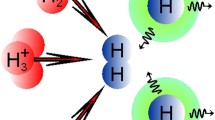Abstract
Results of an experimental study of the process of quenching of excited states ofHF + ions in a hydrofluoride-helium electron-beam plasma are reported. The rate constant of quenching ofA 2∑+(v′=2)HF+ by helium atoms is measured. The ions were excited by activation of the rarefied gas mixture by an electron beam. Diagnostics of internal states of the ions was performed using the electron-vibration-rotation spectrum of their spontaneous emission.
Similar content being viewed by others
References
M. Kriegl, R. Richter, and W. Lindinger, “Vibrational excitation and quenching of N +2 in collision with He at relative energies below 1 eV,”J. Chem. Phys.,88, No. 1, 213–221 1988).
H. K. Shin, “Vibrational relaxation of hydrogen chloride molecules: HCl(v)+HCl(0)→HCl(v−1)+HCl(0),”Chem. Phys. Lett.,98, No. 6, 566–572 (1983).
P. Heinrich and F. Stuhl, “Temperature dependent quenching of CH(A 2Δ), NH(A 3Π), NHc 1Π), and PH(A 3Π) by H2,”Chem. Phys. Lett.,199, 297–304 (1995).
H. Sekiguchi, T. Honda, and A. Kanzawa, “Decomposition of chlorofluorocarbons using thermal argon plasma,” in: 10th Int. Symp. Plasma Chemistry (ISPC-10), 1.5–2, Germany (1991).
Y. N. Tumanov, A. V. Ivanov, V. P. Korovzev, et al., “Plasma conversion of silicium tetrafluoride,” in: 10th Int. Symp. Plasma Chemistry (ISPC-10), 1.5–1, Germany (1991).
G. G. Gartvich, A. E. Zarvin, V. V. Kalyada, and V. Zh. Madirbaev, “Use of electron-bean diagnostics to investigate flows of hydrogen fluoride gas,”Prikl. Mekh. Tekh. Fiz.,34, No. 5, 150–156 (1993).
G. G. Gartvich, A. E. Zarvin, and V. Zh. Madirbaev, “Electron-beam diagnostic of hydrogen fluoride. Optical model and its limitations,”Prikl. Mekh. Tekh. Fiz.,35, No. 1, 151–158 (1994).
H. A. Van Sprang and F. J. De Heer, “A study of the emission spectrum of HF excited by electrons,”J. Chem. Phys.,33, 73–78 (1978).
M. Tichy, G. Javahery, N. D. Twiddy, and E. E. Ferguson, “The vibrational quenching of HCl+ (v=1) and DCl+(v=1) by Ar and Kr,”Chem. Phys. Lett.,144, No. 2, 131–138 (1988).
N. V. Karelov, V. Zh. Madirbaev, and R. G. Sharafutdinov, “Electronic-vibrational emission spectrum of hydrogen chloride excited by an electron beam,”Prikl. Mekh. Tekh. Fiz., No. 2, 3–10 (1987).
V. Zh. Madirbaev and R. G. Sharafutdinov, “Structure of the electron-vibration-rotation spectrum of an HCl+ ion in an electron beam,”Prikl. Mekh. Tekh. Fiz., No. 6, 10–15 (1997).
C. Barbeau, G. Baravian, and J. Jolly, “Rotational temperature measurements in the cathode region of a low pressure DC glow discharge in hydrogen,” in: 10th Int. Symp. Plasma Chemistry (ISPC-10), 2.1.-39, Germany (1991).
J. T. Knudtson and E. Weitz, “Vibrational relaxation of HCl in HCl/liquid xenon mixtures,”Chem. Phys. Lett.,104, No. 1, 71–78 (1984).
Additional information
Novosibirsk State University, Novosibirsk 630090. Translated from Prikladnay Makhanika i Tekhnicheskaya Fizika, Vol. 39, No. 6, pp. 16–20, November–December, 1998
Rights and permissions
About this article
Cite this article
Madirbaev, V.Z., Zarvin, A.E. Collisional quenching of theA 2∑+(v′=2)HF+ state by He atomsstate by He atoms. J Appl Mech Tech Phys 39, 832–836 (1998). https://doi.org/10.1007/BF02468211
Received:
Issue Date:
DOI: https://doi.org/10.1007/BF02468211




